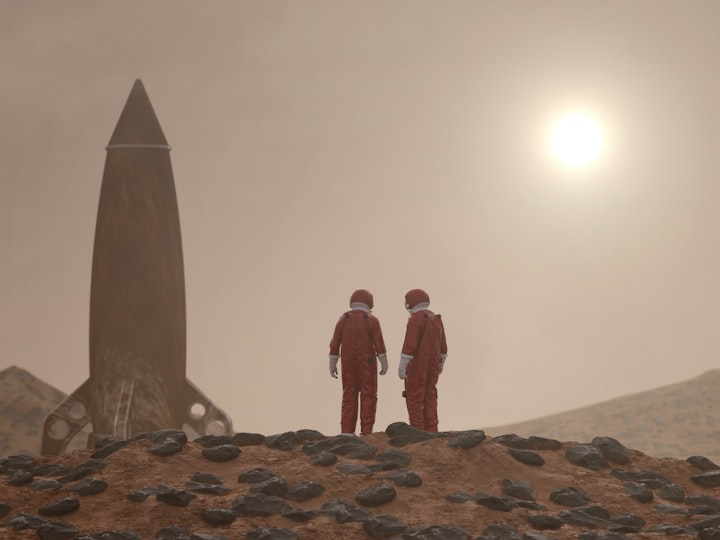Life on Mars in 2030: Colonizing the Red Planet
Imagine a future where humans have conquered the impossible

Imagine a future where humans have conquered the impossible and established a thriving colony on the barren surface of Mars. The year is 2030, and humanity's relentless pursuit of exploration and innovation has led us to achieve what was once considered science fiction. In this article, we will delve into the intricacies of life on Mars, exploring the challenges, triumphs, and remarkable advancements that define this new chapter in human history.
Preparations for the Journey
Technological Innovations for Interplanetary Travel
The journey to Mars is a monumental feat that demands cutting-edge technology. Propulsion systems, radiation shielding, and life support systems have been developed to ensure the safety and comfort of astronauts during the arduous trip. Innovative propulsion methods such as ion drives and advanced solar sails propel spacecraft towards Mars, significantly reducing travel time.
Selecting and Training the Pioneers
The individuals chosen for this historic mission are a diverse group of experts from various fields. Engineers, scientists, doctors, and farmers comprise the team, each contributing their unique skills to ensure the success of the mission. Rigorous training prepares them mentally and physically for the challenges of life on Mars, from conducting extravehicular activities to dealing with isolation and limited resources.
Touchdown on the Red Planet
The Historic Landing and Initial Challenges
The momentous landing on Mars is met with jubilation and anticipation. However, the pioneers immediately encounter the planet's unforgiving environment. Dust storms, extreme temperature fluctuations, and radiation pose immediate challenges. The landing site is carefully selected to balance scientific exploration and safety.
Establishing the First Martian Base
The initial phase of colonization involves constructing a base that serves as a haven for human activity. Advanced 3D printing technology is employed to create habitats, which are then equipped with life support systems, laboratories, and communication facilities. Solar panels and energy storage systems provide the necessary power for survival.
Building a New Home
Terraforming Efforts and Challenges
Terraforming, the process of altering a planet's environment to make it habitable for humans, is a long-term goal for Martian colonization. Scientists explore methods to thicken the atmosphere, release trapped carbon dioxide, and introduce microorganisms that aid in producing oxygen. However, the challenges are immense, and the process is expected to take decades.
Sustainable Living Through Advanced Agriculture
In the barren Martian soil, traditional agriculture is not feasible. Instead, pioneers turn to hydroponics and aeroponics, soilless cultivation methods that optimize resource usage. Plants are nurtured with nutrient-rich water solutions, and LED lights mimic sunlight. Algae cultivation also plays a role in producing oxygen and recycling carbon dioxide.
Architectural Marvels: Martian Habitats
The architects of Mars face the challenge of designing structures that shield inhabitants from radiation, temperature extremes, and dust storms. Dome-shaped habitats made from Martian regolith, reinforced with composite materials, provide protection. Greenhouses with transparent roofs allow for natural light while safeguarding crops.
Exploring the Martian Terrain
Unveiling the Mysteries of Mars
Rovers equipped with state-of-the-art instruments roam the Martian surface, collecting valuable data about its geology, climate, and history. These robotic explorers are remotely controlled from Earth, allowing scientists to analyze rocks, study soil composition, and map terrain features.
Rovers and Their Role in Exploration
Rovers are the eyes and ears of humanity on Mars. Equipped with high-resolution cameras, spectrometers, and drills, they venture into treacherous landscapes, uncovering clues about Mars' past and the potential for habitability. Rovers are integral to identifying locations for future settlements and resource extraction.
Search for Signs of Past or Present Life
One of the most profound questions driving Martian exploration is the search for signs of life. Pioneers investigate ancient riverbeds, dried lake beds, and underground water sources for any indications of microbial life. The discovery of even microbial life would revolutionize our understanding of life's potential prevalence in the universe.
The Martian Society
Governance and Social Structure
As the colony grows, a governance structure emerges to maintain order and address societal needs. A combination of democratic principles and specialized expertise ensures effective decision-making. Regulations are established to manage resources, prevent pollution, and foster cooperation among settlers.
Economy and Resource Management
The Martian economy centres around resource utilization and sustainability. Mining operations extract minerals like iron, nickel, and water ice, which serve as raw materials for construction, manufacturing, and life support systems. The establishment of a self-sufficient economy is crucial for the colony's long-term survival.
Education and Research on Mars
Education flourishes on Mars, with schools and research institutions playing a pivotal role in shaping the future of the colony. Pioneers educate the younger generation in subjects ranging from mathematics and physics to biology and astronomy. Scientific research conducted on Mars yields insights into planetary science, climate change, and potential extraterrestrial life.
Challenges of Martian Life
Psychological and Physiological Adaptations
Isolation and confinement pose significant challenges to mental health. The pioneers must cope with being far from Earth and facing the monotony of life on Mars. Communication with loved ones, virtual reality simulations, and recreational activities help alleviate feelings of isolation.
Dealing with Harsh Environmental Conditions
The Martian environment is harsh, characterized by extreme temperatures, thin atmosphere, and frequent dust storms. Pioneers rely on advanced spacesuits for excursions outside the habitats, while enclosed vehicles provide mobility and protection. These challenges reinforce the need for robust engineering solutions.
Medical Services and Healthcare
Medical facilities equipped with telemedicine capabilities address the settlers' health needs. Diagnostic tools, surgical robots, and 3D printing of medical supplies ensure that medical emergencies can be managed effectively. Regular physical exercise and nutritious diets contribute to the pioneers' overall well-being.
Communication with Earth
Overcoming the Distance Barrier
The vast distance between Mars and Earth results in communication delays of up to 22 minutes. Communication relay stations in space act as intermediaries, ensuring that messages can be transmitted and received in a timely manner. Video calls, email, and social media platforms bridge the interplanetary gap.
Importance of Interplanetary Communication
Staying connected with Earth is essential for maintaining the settlers' mental and emotional well-being. Video messages, virtual gatherings, and collaborative projects with Earth-based counterparts foster a sense of community across the cosmic expanse.
Sustaining Resources
Recycling and Efficient Resource Utilization
Resource scarcity drives pioneers to adopt a culture of recycling and resource efficiency. Waste materials are repurposed, and closed-loop systems ensure minimal waste generation. Sustainable practices extend to water conservation and energy management.
Energy Generation on Mars
Solar panels and other renewable energy sources play a pivotal role in powering the colony. Mars' proximity to the sun provides ample sunlight, which is harnessed to generate electricity for habitats, vehicles, and scientific equipment. Energy storage solutions ensure power availability during periods of low sunlight.
Cultivating Food on Mars
Hydroponics and Aeroponics in Martian Agriculture
Traditional farming methods are not viable on Mars due to the lack of fertile soil. Hydroponics and aeroponics utilize nutrient-rich water solutions to nourish plants, while LED lights simulate sunlight. These methods result in efficient resource utilization and year-round crop production.
Genetically Modified Crops for Martian Soil
Scientists engineer crops that are genetically modified to thrive in Martian soil conditions. These crops are engineered to withstand low nutrient levels and adapt to the harsh environment. Genetic modifications ensure higher yields and improved nutritional content.
FAQs about Life on Mars
1. Will humans be able to breathe on Mars?
No, Mars' thin atmosphere cannot support human respiration. Habitats will maintain a controlled atmosphere with breathable air.
2. How will pioneers stay connected with Earth?
Communication relay stations and advanced technology enable regular contact through messages and video calls.
3. What challenges will pioneers face due to isolation?
Isolation can lead to psychological strain and feelings of loneliness. Communication with loved ones and support systems is vital for mental well-being.
4. Is there water on Mars?
Yes, water exists on Mars in the form of ice in polar ice caps and potentially underground aquifers.
5. How will pioneers address medical emergencies?
Medical facilities equipped with telemedicine capabilities will address medical emergencies. Surgical robots and diagnostic tools will aid in medical care.
Conclusion
The colonization of Mars in 2030 marks a historic achievement that combines human ingenuity, determination, and collaboration. Pioneers on the Red Planet face unprecedented challenges, but their triumphs offer a glimpse into the limitless potential of humanity's future. As we look to the stars, the colonization of Mars reminds us that exploration and discovery know no bounds, igniting our curiosity and inspiring generations to come.
About the Creator
Tracey te Braake
I love writing and I want to bring joy to my readers as they lose themselves in my words.






Comments
There are no comments for this story
Be the first to respond and start the conversation.